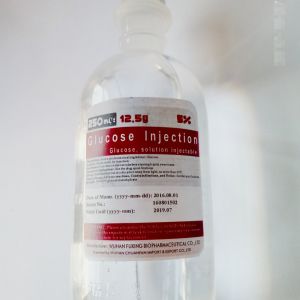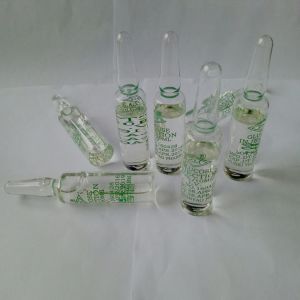Basic information
Description
this product is colorless or almost colorless transparent liquid;
Sweet taste.
Contraindications
(1) uncontrollor of diabetic ketoacidosis;
(2) hypertonic hypertonic state of hyperglycemia;
Composition
The characteristics of the quality of the quality of the products in accordance with the provisions of this article are in accordance with the provisions of this article
Acidity ml acuities were 1.2, 0.2 or less chloride, sulfate, 200 PPM or less 30 or less 200 PPM or less 30 or less insolubles in ethanol, at 0.5 mg 5 or less shallow turbidity standard pipe sulfite and soluble starch show yellow yellow dry weightlessness, % 9.5 9.1 or less or less on ignition residue, % 0.2 0.1 or less or less iron salts, PPM 20 or less 5 or less heavy metals, PPM arsenic 20 or less 4 or less salt, PPM or less 2 0.1 or less
Glucose is one of the main sources of heat in the body, and glucose can produce 4 calories (16.7 kilojoules) per gram of glucose, so it is used to replenish heat.
Treat hypoglycemia.
When glucose and insulin are injected with intravenous drip, the synthesis of glycogen requires potassium ion to participate, thus potassium ions enter the cell and the concentration of blood potassium drops, so it is used to treat hyperkalaemia.
The rapid intravenous injection of hypertonic glucose injection has the effect of tissue dehydrating agent.
In addition, glucose is the main substance that maintains and regulates the osmotic pressure of the peritoneal dialysis fluid.
Usage
(1) patients who are supplementing thermal energy may normally give 25% glucose injection of glucose injection and supplement fluids while eating less or not eating.
Glucose dosage is calculated according to the thermal energy required.
(2) total intravenous nutrition therapy glucose is the most important energy supply for this therapy.
In non-protein thermal energy, the ratio of glucose to fat supply is 2:1. Specific dosage is determined according to the clinical heat need.
According to the need of the filling amount, the glucose can be prepared as 25% ~ 50% different concentration, and insulin is added when necessary, and 1 unit of normal insulin is added every 5 ~ 10g glucose.
Due to the normal use of hypertonic glucose solution, the intravenous stimulation is large and the infusion of fat emulsions is required, so the intravenous drip is commonly used.
(3) hypoglycemia, which can be used to inject 20 ~ 40ml intravenously with 50% glucose injection.
(4) hungry ketosis, severe application of 5% ~ 25% glucose injection of glucose injection, daily 100g of glucose can basically control the disease.
(5) water leakage and other infiltration water were given 5% glucose injection.
(6) hyperkalaemia is used for 10 to 25% injection, and 1 unit of normal insulin infusion per 2 ~ 4g glucose can reduce the serum potassium concentration.
But the treatment only allowed the extracellular potassium ions to enter the cell, and the total potassium content remained constant.
If potassium is not taken, there may be another possibility of hyperkalemia.
(7) tissue dehydration hypertonic solution (commonly used 50% glucose injection) rapid intravenous injection of 20 ~ 50ml.
But it was short-lived.
It is necessary to guard against high blood sugar in clinical practice.
In order to regulate the osmotic pressure of the peritoneal dialysis fluid, 50% of the glucose injection 20ml or 10g of glucose can improve the osmotic pressure of 1L peritoneal dialysis.
Adverse reactions
(1) phlebitis occurred in the injection of hypertonic glucose injection.
For example, the incidence of phlebitis decreases with intravenous drip.
(2) high concentration of glucose injection can cause local swelling.
(3) reactive hypoglycemia: combined use of insulin overdose, the original hypoglycemia tendency and total venous nutrition therapy sudden stop is easy to occur.
(4) high blood sugar of ketosis coma, see more at diabetes, stress state, use a lot of glucocorticoid, uremia patients with peritoneal dialysis intra-abdominal hypertonic glucose solution and full nutrition therapy.
(5) electrolyte disturbance: low potassium, low sodium and hypophosphatemia are easy to be found in long-term simple supply of glucose.
(6) original cardiac dysfunction.
(7) hyperkalemia: with high concentration of glucose diabetes patients occasionally occur.
Notes
(1) use the previous inspection, if the liquid is cloudy, the color change, the aluminum cover is loosened and not used.
(2) excessive glucose can stimulate fetal insulin secretion during delivery, and hypoglycemia occurs in postpartum infants.
(3) used in the following circumstances: (1) most gastric resection patients make oral glucose tolerance test is easy to appear the dumping syndrome and hypoglycemia, should be changed to intravenous glucose test: (2), hypokalemia periodic paralysis patients;
Hyperglycemia can be induced by stress or glucocorticoids.
Edema and severe heart, renal insufficiency, cirrhosis ascites, easy to water retention, should control infusion volume;
The insufficiency of cardiac function should control the rate of drop.
Drug dosage
Pregnant women and lactating women: excessive injections of glucose during delivery can stimulate fetal insulin secretion and hypoglycemia in postnatal infants.
Children's medicine: excessive and excessive, too much, can cause heart palpitation, arrhythmia, even acute left heart failure
Elderly patients use drugs: too fast, too much, can cause heart palpitation, arrhythmia, even acute left heart failure.
| Generic name | glucose injection |
| English name | GLUCOSE INJECTION |
| Drug class | regulating water salt, electrolyte and acid-base balance |
Description
this product is colorless or almost colorless transparent liquid;
Sweet taste.
Contraindications
(1) uncontrollor of diabetic ketoacidosis;
(2) hypertonic hypertonic state of hyperglycemia;
Composition
The characteristics of the quality of the quality of the products in accordance with the provisions of this article are in accordance with the provisions of this article
Acidity ml acuities were 1.2, 0.2 or less chloride, sulfate, 200 PPM or less 30 or less 200 PPM or less 30 or less insolubles in ethanol, at 0.5 mg 5 or less shallow turbidity standard pipe sulfite and soluble starch show yellow yellow dry weightlessness, % 9.5 9.1 or less or less on ignition residue, % 0.2 0.1 or less or less iron salts, PPM 20 or less 5 or less heavy metals, PPM arsenic 20 or less 4 or less salt, PPM or less 2 0.1 or less
Glucose is one of the main sources of heat in the body, and glucose can produce 4 calories (16.7 kilojoules) per gram of glucose, so it is used to replenish heat.
Treat hypoglycemia.
When glucose and insulin are injected with intravenous drip, the synthesis of glycogen requires potassium ion to participate, thus potassium ions enter the cell and the concentration of blood potassium drops, so it is used to treat hyperkalaemia.
The rapid intravenous injection of hypertonic glucose injection has the effect of tissue dehydrating agent.
In addition, glucose is the main substance that maintains and regulates the osmotic pressure of the peritoneal dialysis fluid.
Usage
(1) patients who are supplementing thermal energy may normally give 25% glucose injection of glucose injection and supplement fluids while eating less or not eating.
Glucose dosage is calculated according to the thermal energy required.
(2) total intravenous nutrition therapy glucose is the most important energy supply for this therapy.
In non-protein thermal energy, the ratio of glucose to fat supply is 2:1. Specific dosage is determined according to the clinical heat need.
According to the need of the filling amount, the glucose can be prepared as 25% ~ 50% different concentration, and insulin is added when necessary, and 1 unit of normal insulin is added every 5 ~ 10g glucose.
Due to the normal use of hypertonic glucose solution, the intravenous stimulation is large and the infusion of fat emulsions is required, so the intravenous drip is commonly used.
(3) hypoglycemia, which can be used to inject 20 ~ 40ml intravenously with 50% glucose injection.
(4) hungry ketosis, severe application of 5% ~ 25% glucose injection of glucose injection, daily 100g of glucose can basically control the disease.
(5) water leakage and other infiltration water were given 5% glucose injection.
(6) hyperkalaemia is used for 10 to 25% injection, and 1 unit of normal insulin infusion per 2 ~ 4g glucose can reduce the serum potassium concentration.
But the treatment only allowed the extracellular potassium ions to enter the cell, and the total potassium content remained constant.
If potassium is not taken, there may be another possibility of hyperkalemia.
(7) tissue dehydration hypertonic solution (commonly used 50% glucose injection) rapid intravenous injection of 20 ~ 50ml.
But it was short-lived.
It is necessary to guard against high blood sugar in clinical practice.
In order to regulate the osmotic pressure of the peritoneal dialysis fluid, 50% of the glucose injection 20ml or 10g of glucose can improve the osmotic pressure of 1L peritoneal dialysis.
Adverse reactions
(1) phlebitis occurred in the injection of hypertonic glucose injection.
For example, the incidence of phlebitis decreases with intravenous drip.
(2) high concentration of glucose injection can cause local swelling.
(3) reactive hypoglycemia: combined use of insulin overdose, the original hypoglycemia tendency and total venous nutrition therapy sudden stop is easy to occur.
(4) high blood sugar of ketosis coma, see more at diabetes, stress state, use a lot of glucocorticoid, uremia patients with peritoneal dialysis intra-abdominal hypertonic glucose solution and full nutrition therapy.
(5) electrolyte disturbance: low potassium, low sodium and hypophosphatemia are easy to be found in long-term simple supply of glucose.
(6) original cardiac dysfunction.
(7) hyperkalemia: with high concentration of glucose diabetes patients occasionally occur.
Notes
(1) use the previous inspection, if the liquid is cloudy, the color change, the aluminum cover is loosened and not used.
(2) excessive glucose can stimulate fetal insulin secretion during delivery, and hypoglycemia occurs in postpartum infants.
(3) used in the following circumstances: (1) most gastric resection patients make oral glucose tolerance test is easy to appear the dumping syndrome and hypoglycemia, should be changed to intravenous glucose test: (2), hypokalemia periodic paralysis patients;
Hyperglycemia can be induced by stress or glucocorticoids.
Edema and severe heart, renal insufficiency, cirrhosis ascites, easy to water retention, should control infusion volume;
The insufficiency of cardiac function should control the rate of drop.
Drug dosage
Pregnant women and lactating women: excessive injections of glucose during delivery can stimulate fetal insulin secretion and hypoglycemia in postnatal infants.
Children's medicine: excessive and excessive, too much, can cause heart palpitation, arrhythmia, even acute left heart failure
Elderly patients use drugs: too fast, too much, can cause heart palpitation, arrhythmia, even acute left heart failure.

 China
China